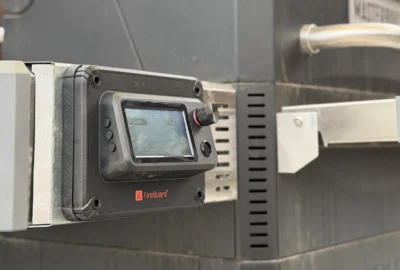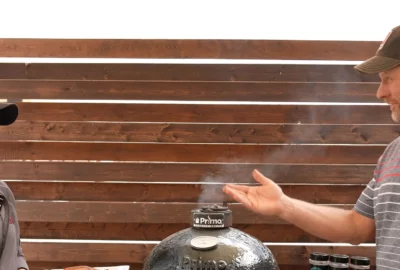Science, Smoking & Grilling World
Smoking at High and Low Temperatures
Following up on our post looking at the different colors of smoke and the variety of flavors you can get from burning at different temperatures, this post will discuss the pros and cons of Low and Slow versus Fast and Hot cooking approaches.

For a pork shoulder using a low & slow cook, the FireBoard Drive set point was well below 200ºF for most of the 17-hour cook time.
Apart from smoke color, the temperature at which the meat is smoked plays a significant role in determining the final flavor profile, not to mention the texture and juiciness. In a recent conversation, Meathead G explained that the best way to control the texture and moisture of your cook is through temperature control. He emphasized, “Your thermometer is the single most important tool, more important than a sharp knife.”
Low and Slow

An example of a low and slow brisket cook, most of this 13-hour cook used a FireBoard Drive setpoint at or below 225ºF.
The traditional method of smoking involves cooking meat at a low temperature (between 225-250°F) over an extended period. This slow cooking allows the smoke to gently permeate the meat, creating a tender, smoky, and well-rounded flavor profile. The low heat also breaks down collagen in the connective tissues, resulting in tender and juicy ribs, brisket, and pork shoulder.
Pros
Tender Perfection: The extended cooking time of low and slow smoking breaks down the connective tissues and collagen in the meat, resulting in unparalleled tenderness. This method turns even the toughest cuts into culinary masterpieces.
Deep Flavor Penetration: With prolonged exposure to smoke, the meat has ample time to absorb complex flavors, resulting in a rich taste profile.
Forgiving Temperatures: Low and slow cooking requires more precise temperature control, but it’s forgiving when it comes to potential fluctuations. Small variations over longer periods are less likely to ruin the final product.
Cons
Time Intensive: The most obvious drawback of low and slow cooking is the time it takes. Hours, and sometimes even days, are required for the full process. This might not be suitable for those looking for a quick meal.
Attention and Patience: Low and slow cooking demands your constant attention and patience. It’s a commitment that not everyone is prepared to make.
Crispiness Challenge: Achieving a crispy crust with low and slow cooking can be a bit tricky. While the interior might be tender, getting that desired crust can require additional steps or techniques.

Our neighbors at Wolfepack BBQ use a 1,000-gallon smoker for the traditionally tougher pieces of meat like brisket and pork shoulder. They use a similar, yet smaller 500-gallon smoker for their hot and fast smoking of chicken and sausage.
Hot and Fast

An example of a fast and hot brisket cook, using a FireBoard Drive setpoint at 300ºF for less than 8 hours.
Some pitmasters prefer the hot and fast approach, smoking meat at higher temperatures (around 300-350°F) for a shorter duration. While this method can produce flavorful bark on the meat’s surface, it may not allow enough time for the smoke to penetrate the meat. Consequently, the smoke flavor might be less pronounced compared to the low and slow method.
Pros
Speedy Results: As the name suggests, the hot and fast method delivers quicker results. With higher temperatures, you can have your barbecue ready in a fraction of the time compared to low and slow cooking.
Crisp Crust: The intense heat of hot and fast smoking can produce a beautifully caramelized crust on the meat. This crust locks in flavors and adds an irresistible texture to the final product.
Juicy Meats: Despite the speed, hot and fast cooking can still produce juicy results. The high heat sears the outer layer of meat, sealing in the moisture and flavor.
Cons
Potential Toughness: Rapid cooking can sometimes lead to less tender meat, especially if the cuts are tougher to begin with. The collagen breakdown that leads to that melt-in-the-mouth tenderness might not fully occur in the shorter cooking time.
Limited Flavor Infusion: With less time for the meat to absorb the smoke, the flavor profile might be less developed compared to low and slow cooking.
Temperature Control: Maintaining precise temperature control can be challenging with the hot and fast method. Fluctuations can lead to uneven cooking and potentially uneven results.
Whichever path you choose, remember that BBQ smoking is both an art and a science, and mastering either technique requires practice, experimentation, and a deep appreciation for the alchemical dance of heat, smoke, and meat. So, fire up the smoker, embrace your culinary journey, and savor every bite of the delicious results that unfold before you.

John cooked two steaks to the same internal temperature as measured by a Spark. One set at medium stove burner setting and the other on low. The steak cooked at the higher temperature reached the internal temp faster and created a delightful seared surface, a perfect Maillard reaction.
A footnote about the Malliard Reaction,
The Maillard reaction is a crucial culinary reaction that occurs when heat transforms amino acids (found in proteins) and reducing sugars into a complex, flavorful array of compounds. This reaction is responsible for the appealing colors, aromas, and flavors of a perfectly seared steak or the tasty bark found on smoked brisket and pork shoulder.

At left is the hot and fast steak exhipbiting attractive golden brown sear!









4 Comments
J.R. Fortenberry
I use hot & fast for bone in chicken breast and wings. I like a lot of (good) smoke flavor and I get plenty using competition pellets along with 1 or 1 pellet tubes full of hickory pellets. Low & slow works fine also but I find the skin of the chicken to be much crisper using the hot & fast method.
Oh, I cook on a rectec RT700 Bull
Be blessed!
J.R.
Jeff Nichols
Sounds like you are getting good results J.R. Thanks for sharing your process, I am sure others will give want to give it a try!
josh
Can you comment on the ideal temperature to “break down collagen”.
It seems the default temperature for most recipes is 204 but I just can’t get the science behind this.
I’m slowly dropping and 195 seems to be good, if not better than 204.
Heading to 180……..
How low do I go?
?? comments??
Josh
Jeff Nichols
Hey Josh, FireBoard includes Meathead’s Food Temperature Guide with every Spark thermometer we sell. Along with an extensive list of standard safety temperatures for common foods, it also includes a list of other useful temperatures. Here he lists collagens melting in the range of 160-205ºF, which sounds like a good range for you to experiment with. Click here for his in-depth article on this thermic reaction.